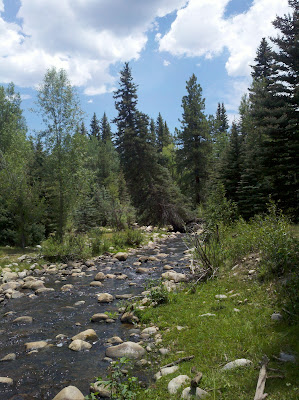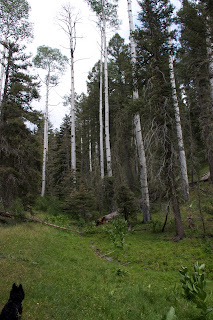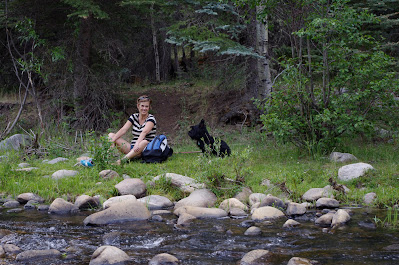 |
| The lookout cabin. |
 |
| Upper Canjilon Lake |
We did this hike our second day of our stay in El Rito. The drive from town is about 30 miles or so but took about an hour. There are few rough sections along the roads( NM 110 and FR 559) requiring at least high clearance, and if it's wet probably 4 wheel drive. The road up to the lakes however is paved. When we drove back we headed west to make a loop through Canjilon and Abiquiu. The road from this direction is a very good all weather gravel road that is suitable for almost any vehicle. The hike starts out at the popular( relatively speaking) Canjilon Lakes fishing and camping area. We drove to the very end of the road where there is a parking area at Upper Canjilon Lake. There was an obvious trail at the back of the lot next to the bathroom. There are some brown trail markers, but no sign indicating the trail name or number. We walked through a now off limits picnic area. The reason it's off limits is due to the many dead aspen trees that are liable to topple over when the next strong wind blows through. The forest service is trying to get them cut down here and in the campgrounds along the lakes, but there are so many it's going to take awhile. I can only imagine what this beautiful area looked liked when the aspens were healthy, because during our drive and walk I would estimate that 95% or more were either dead or about to be finished off by web worms.
 |
| Dead aspens |

Heading north we came to a fork in the trail after less than a mile. One
branch led down to Canjilon Creek, the other went up hill along a
tributary (you can go either way as this a lollipop loop type hike). We
went up and it was nice getting out of the dead aspen stands into a live
green forest of spruce, pine, and fir. This part of the trail is the only
steep section. It eventually levels off and then begins to climb
gradually to the the top of Canjilon Mountain. There's definitely a "
the hills are alive . . ." type of feeling when you emerge from the
dark forest onto the wide, grassy (dotted with a few clumps of spruce)
open mountain top with views swinging from the southeast to the
northwest. We enjoyed our lunch here. We then walked up to the tiny
shack at the summit and read the story of the lookout that was killed by
lightning in 1922. And if that isn't enough warning, let me just say this
isn't a good place to be when the dark clouds start gathering, so try
and get this hike over and done early in the summer months.


From the cabin we
headed north on an old (closed, but we noticed it still may be getting
some traffic) road. Along this stretch I'd wished I had studied the map
on the Carson National Forest site a little more closely. In my mind the
trail was like a square, but really it was more like a trapezoid and we were now on the longest parallel side. I kept looking for and wanting
the turn back to the east, and even walked a ways down one valley
hoping it was the route, before spotting the road again on the other
side. Note: this entire route is marked with either cairns, brown trail
markers or blazes on trees, there is no need to improvise, although
there are a couple spots where the indicators are rather far apart. I
wasn't worried about getting lost, so much as missing the turn and
walking all the way to Trout Lakes which would have made a much longer
hike and probably would have caught us out in the rain. There was,
finally, the fork, and we turned east into the Canjilon Meadows where
our hot and thirsty Scottie Seamus promptly laid down on the cool moss
growing on top of a muddy spring. Second Note: except for the stretch
along mountain top ridge, most of this hike should have water year
round, but this area is in a severe drought (hence the dead aspens), so
carry plenty of water at least until the area gets soaked (hopefully)
by the summer rains.
We continued on (quickly now as this was another
good spot to become a lightning rod and the clouds were starting to
gather) through what should be a large wet meadow and source of Canjilon
Creek. Most of it was dry which made for easier walking, and eventually we
came to a hillside with small rivulets of water flowing in from the west
where Seamus got in and drank, and then we walked down to the creek
itself. The trail follows the small stream from here, sometimes
closely, sometimes well above, back to the original trail fork. We saw
some cutthroat trout in the deeper pools of the very low creek.Wishing
them luck, we made it back just in time to get in our truck and drive
out in the pouring rain. This hike is around 8.5-9.0 miles with about
800 feet of elevation gain(10,100ft-10,900ft).
 |
| Meadows leading down to Canjilon Creek |
 |
| Canjilon Creek |
Labels: hiking












































